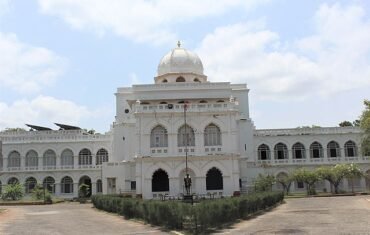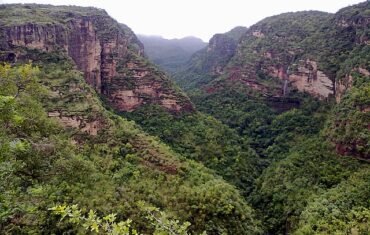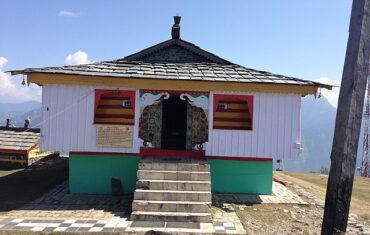The Lakshmana Temple is a 10th-century Hindu temple built by Yashovarman during the Chandela dynasty located in Khajuraho, India. It is dedicated to Vaikuntha Vishnu – an aspect of Vishnu. As part of the Khajuraho Group of Monuments, and owing to its architecture and religious importance, the temple was inscribed on the UNESCO World Heritage List in 1986. Visit during Khajuraho One day tour By cab
Overview of Lakshmana Temple-Khajuraho
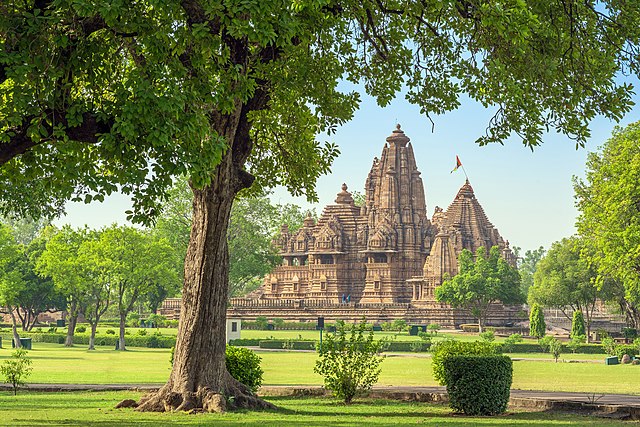
The Lakshmana Temple is one of the oldest and most ornate temples in the Western group of Khajuraho. It was built by King Yashovarman, who consolidated the Chandela power in the region and established Khajuraho as his capital. The temple was consecrated in 954 CE, as per an inscription on its doorway. The temple is dedicated to Vaikuntha Vishnu, a form of Vishnu who resides in the highest heaven. The temple has a three-headed idol of Vishnu in the sanctum, with the central head being human, and the two sides being boar (Varaha) and lion (Narasimha). Top 11 Places To Visit in Khajuraho
The temple also has sculptures of various deities, such as Brahma, Shiva, Ganesha, and Durga, as well as scenes from the Hindu epics, such as the Ramayana and the Mahabharata. The temple is famous for its exquisite carvings and erotic sculptures, which depict various aspects of human life and spirituality. The temple is a masterpiece of the Nagara style of architecture, which is characterized by a curvilinear tower (shikhara) over the sanctum, a vestibule (antarala), a hall (mandapa), and a porch (ardhamandapa).
The temple stands on a high platform (jagati), and is surrounded by four smaller shrines at the corners. The temple is a symbol of the Chandela culture, which was open and liberal about sexuality and spirituality.
Location of Lakshmana Temple-Khajuraho

The Lakshmana Temple is located in the Western Temple complex in Khajuraho, Madhya Pradesh, India. Khajuraho is a small town in the Chhatarpur district, about 175 kilometres (109 miles) southeast of Jhansi. Khajuraho was the capital of the Chandela dynasty, which ruled over a large part of central India from the 9th to the 13th centuries CE.
The Chandela rulers built over 80 temples in Khajuraho, out of which about 30 survive today. The temples are divided into three groups: Western, Eastern, and Southern. The Western group is the largest and the most prominent, containing the finest and the most elaborate temples. The Eastern group consists of mainly Jain temples, while the Southern group has a few Hindu temples.
Timing/Entry Fees Lakshmana Temple-Khajuraho
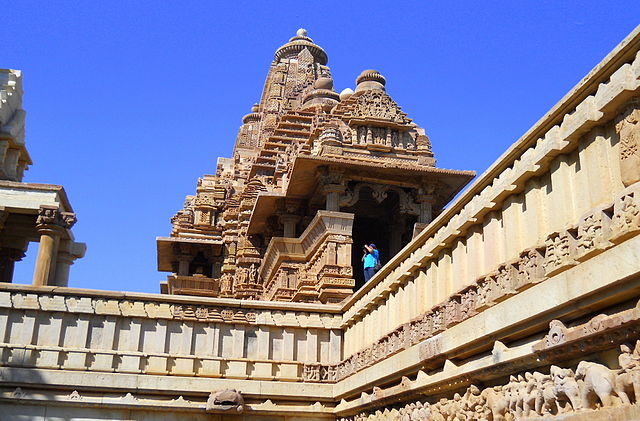
The Lakshmana Temple is open for visitors from sunrise to sunset, every day of the week. The entry fee for Indian nationals is Rs. 40 per person, while for foreign nationals it is Rs. 600 per person. Children below the age of 15 years are allowed free entry. There is also a light and sound show in the evening, narrated by the Bollywood actor Amitabh Bachchan, that showcases the history and significance of the Khajuraho temples. The show timings are 6:30 pm to 7:25 pm in Hindi and 7:40 pm to 8:35 pm in English. The ticket price for the show is Rs. 250 for adults and Rs. 150 for children.
How to Reach Lakshmana Temple-Khajuraho

Khajuraho is well connected by road, rail, and air to major cities in India. The nearest airport is the Khajuraho Airport, which is about 9 kilometres (5.6 miles) from the town. There are regular flights from Delhi, Varanasi, and Agra to Khajuraho.
The nearest railway station is the Khajuraho Railway Station, which is about 8 kilometres (5 miles) from the town. There are trains from Delhi, Agra, Jhansi, Bhopal, and Udaipur to Khajuraho.
The nearest bus stand is the Khajuraho Bus Stand, which is about 1 kilometre (0.6 miles) from the town. There are buses from Chhatarpur, Jhansi, Satna, and Panna to Khajuraho. One can also hire a taxi, auto-rickshaw, or cycle-rickshaw to reach the Lakshmana Temple from the town.
Things to Do Lakshmana Temple-Khajuraho

The Lakshmana Temple offers a lot of things to do for the visitors, apart from admiring the stunning architecture and sculptures. Some of the things to do are:
- Visit the Archaeological Museum, which is located near the Western group of temples. The museum displays a collection of sculptures, inscriptions, architectural fragments, and other artefacts from the Khajuraho temples. The museum is open from 10 am to 5 pm, except on Fridays. The entry fee is Rs. 10 per person.
- Enjoy a boat ride on the Khajur Sagar, a lake that lies adjacent to the Western group of temples. The lake offers a scenic view of the temples and the surrounding landscape. The boat ride costs Rs. 50 per person for 30 minutes.
- Explore the nearby attractions, such as the Raneh Falls, a natural waterfall that is about 20 kilometres (12 miles) from Khajuraho. The falls are formed by the Ken River and have a series of rock formations that create a canyon-like effect. The falls are best visited during the monsoon season, when the water level is high.
- Experience the local culture and cuisine, by visiting the Khajuraho Dance Festival, an annual event that is held in February or March. The festival showcases the classical dance forms of India, such as Bharatanatyam, Kathak, Odissi, Kuchipudi, and Manipuri. The festival is held in the open-air auditorium near the Chitragupta Temple and attracts performers and spectators from all over the world. The local cuisine of Khajuraho is influenced by the Bundelkhand region and consists of dishes such as bafla, dal, kusli, lavang lata, and mawa bati.
Significance of Lakshmana Temple-Khajuraho
The Lakshmana Temple is significant for various reasons, such as:
- It represents the peak of the Chandela art and architecture, which was influenced by the Gupta and the Pratihara styles. The temple is built of sandstone, without any mortar, and has intricate carvings and sculptures that cover the walls, pillars, ceilings, and roofs. The temple has a common plan, consisting of a sanctum (garbhagriha), a vestibule (antarala), a hall (mandapa), and a porch (ardhamandapa). The sanctum is surmounted by a curvilinear tower (shikhara), which has smaller towers (urushringas) on its sides. The temple also has balconies, windows, and projections that add to the aesthetic appeal.
- It reflects the religious tolerance and diversity of the Chandela society, which patronized both Hinduism and Jainism. The temple is dedicated to Vaikuntha Vishnu, a form of Vishnu who resides in the highest heaven. The temple also depicts scenes from the Hindu epics, such as the Ramayana and the Mahabharata, as well as the Jain legends, such as the life of Mahavira. The temple also has images of various gods and goddesses, celestial beings, mythical creatures, animals, birds, and plants.
- It expresses the philosophy and worldview of the Chandela culture, which celebrated life and its various aspects. The temple is famous for its erotic sculptures, which constitute about 10% of the total sculptures. These sculptures depict various forms of love, such as romantic, erotic, maternal, and spiritual. The sculptures also illustrate the four goals of life in Hinduism, namely dharma (duty), artha (wealth), kama (pleasure), and moksha (liberation). The sculptures also symbolize the union of the male and female principles, which is the essence of creation.
FAQ’s
Some of the frequently asked questions about the Lakshmana Temple are:
Q: Why is the Lakshmana Temple named so?
A: The Lakshmana Temple is named after the brother of Rama, the hero of the Ramayana epic. According to a legend, the temple was built on the spot where Lakshmana killed the demon king Ravana, who had abducted Rama’s wife Sita. Another legend says that the temple was named after a Chandela prince named Lakshavarman, who was a devotee of Vishnu.
Q: What is the significance of the three-headed idol of Vishnu in the Lakshmana Temple?
A: The three-headed idol of Vishnu in the Lakshmana Temple is a rare and unique representation of the god. The three heads symbolize the three aspects of Vishnu: creation, preservation, and destruction. The human head represents Vishnu as the preserver of the universe, the boar head represents Vishnu as the rescuer of the earth from the cosmic ocean, and the lion head represents Vishnu as the protector of the righteous from the evil.
Q: What are the erotic sculptures on the Lakshmana Temple?
A: The erotic sculptures on the Lakshmana Temple are part of the artistic expression of the Chandela culture, which celebrated life and its various aspects. The erotic sculptures depict various forms of love, such as romantic, erotic, maternal, and spiritual. The erotic sculptures also illustrate the four goals of life in Hinduism, namely dharma (duty), artha (wealth), kama (pleasure), and moksha (liberation). The erotic sculptures also symbolize the union of the male and female principles, which is the essence of creation.
Conclusion
The Lakshmana Temple is a splendid example of the Chandela art and architecture, that showcases the rich cultural heritage of the dynasty. The temple is a masterpiece of the Nagara style of architecture, which is characterized by a curvilinear tower over the sanctum, a vestibule, a hall, and a porch. The temple stands on a high platform and is surrounded by four smaller shrines at the corners.
The temple is dedicated to Vaikuntha Vishnu, a form of Vishnu who resides in the highest heaven. The temple has a three-headed idol of Vishnu in the sanctum, with the central head being human, and the two sides being boar and lion. The temple also has sculptures of various deities, such as Brahma, Shiva, Ganesha, and Durga, as well as scenes from the Hindu epics, such as the Ramayana and the Mahabharata.
The temple is famous for its exquisite carvings and erotic sculptures, which depict various aspects of human life and spirituality. The temple is a must-visit for anyone who wants to witness the beauty and glory of ancient Indian civilization.


